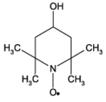Replaces Prod. #: BML-FR118
Small molecule cell-permeable superoxide dismutase (SOD) mimetic. It attenuates superoxide anion and peroxynitrite-induced inflammation, lowers blood peressure in a variety of models and displays neuroprotective effects. It restores mitochondrial and cardiac functions in TNFα-induced oxidative stress and reduces cardiac hypertrophy in chronic hypoxic rats.
Product Details
| Alternative Name: | 4-OH-TEMPO, 4-Hydroxy-TEMPO, 4-Hydroxy-2,2,6,6-tetramethylpiperidinyloxy, free radical |
| |
| Formula: | C9H18NO2 |
| |
| MW: | 172.2 |
| |
| CAS: | 2226-96-2 |
| |
| Purity: | ≥98% (HPLC) |
| |
| Appearance: | Yellow to orange crystalline solid. |
| |
| Solubility: | Soluble in water, 100% ethanol, methanol or DMSO. |
| |
| Shipping: | Blue Ice |
| |
| Long Term Storage: | -20°C |
| |
| Handling: | Protect from light. |
| |
| Regulatory Status: | RUO - Research Use Only |
| |
Please mouse over
Product Literature References
Aristolochic acid I induces proximal tubule injury through ROS/HMGB1/mt DNA mediated activation of TLRs: R. Upadhyay, et al.; J. Cell. Mol. Med.
26, 4277 (2022),
Abstract;
Therapeutic targeting of mitochondrial superoxide in hypertension: A.E. Dikalova, et al.; Circ. Res.
107, 106 (2010),
Abstract;
Mitochondrial oxidative stress and dysfunction in myocardial remodelling: H. Tsutsui, et al.; Cardiovasc. Res.
81, 449 (2009),
Abstract;
Full Text
A mitochondria-targeted nitroxide is reduced to its hydroxylamine by ubiquinol in mitochondria: J. Trnka, et al.; Free Radic. Biol. Med.
44, 1406 (2008),
Abstract;
TNF-alpha-induced mitochondrial oxidative stress and cardiac dysfunction: restoration by superoxide dismutase mimetic Tempol: N. Mariappan, et al.; Am. J. Physiol. Heart Circ. Physiol.
293, H2726 (2007),
Abstract;
Acute effects of the superoxide dismutase mimetic tempol on split kidney function in two-kidney one-clip hypertensive rats: G.S. Guron, et al.; J. Hypertens.
24, 387 (2006),
Abstract;
Neuroprotective effects of the stable nitroxide compound Tempol on 1-methyl-4-phenylpyridinium ion-induced neurotoxicity in the Nerve Growth Factor-differentiated model of pheochromocytoma PC12 cells: T. Lipman, et al.; Eur. J. Pharmacol.
549, 50 (2006),
Abstract;
Probing the intracellular redox status of tumors with magnetic resonance imaging and redox-sensitive contrast agents: F. Hyodo, et al.; Cancer Res.
66, 9921 (2006),
Abstract;
TEMPOL, a membrane-permeable radical scavenger, attenuates peroxynitrite- and superoxide anion-enhanced carrageenan-induced paw edema and hyperalgesia: a key role for superoxide anion: M.M. Khattab; Eur. J. Pharmacol.
548, 167 (2006),
Abstract;
The effects of tempol, 3-aminobenzamide and nitric oxide synthase inhibitors on acoustic injury of the mouse cochlea: H. Murashita, et al.; Hear. Res.
214, 1 (2006),
Abstract;
The nitroxide Tempol modulates anthracycline resistance in breast cancer cells: M.B. Gariboldi, et al.; Free Radic. Biol. Med.
40, 1409 (2006),
Abstract;
The role of oxidant stress in angiotensin II-mediated contraction of human resistance arteries in the state of health and the presence of cardiovascular disease: M.B. Hussain, et al.; Vascul. Pharmacol.
45, 395 (2006),
Abstract;
Antioxidant enzymes and effects of tempol on the development of hypertension induced by nitric oxide inhibition: J. Sainz, et al.; Am. J. Hypertens.
18, 871 (2005),
Abstract;
Cancer chemoprevention by the antioxidant tempol acts partially via the p53 tumor suppressor: L. Erker, et al.; Hum. Mol. Genet.
14, 1699 (2005),
Abstract;
Neuroprotective effects of TEMPOL in central and peripheral nervous system models of Parkinson’s disease: Q. Liang, et al.; Biochem. Pharmacol.
70, 1371 (2005),
Abstract;
Systemic arterial pressure response to two weeks of Tempol therapy in SHR: involvement of NO, the RAS, and oxidative stress: L. Yanes, et al.; Am. J. Physiol. Regul. Integr. Comp. Physiol.
288, R903 (2005),
Abstract;
Tempol, one of nitroxides, is a novel ultraviolet-A1 radiation protector for human dermal fibroblasts: S.X. Yan, et al.; J. Dermatol. Sci.
37, 137 (2005),
Abstract;
Tempol lowers blood pressure and sympathetic nerve activity but not vascular O2- in DOCA-salt rats: H. Xu et al.; Hypertension
43, 329 (2004),
Abstract;
The superoxide dismutase mimetic, tempol, blunts right ventricular hypertrophy in chronic hypoxic rats: B. Elmedal et al.; Br. J. Pharmacol.
141, 105 (2004),
Abstract;
Nitroxide TEMPOL impairs mitochondrial function and induces apoptosis in HL60 cells: E. Monti, et al.; J. Cell. Biochem.
82, 271 (2001),
Abstract;
Spin trapping agents (Tempol and POBN) protect HepG2 cells overexpressing CYP2E1 against arachidonic acid toxicity: M.J. Perez & A.I. Cederbaum; Free Radic. Biol. Med.
30, 734 (2001),
Abstract;
The nitroxide tempol induces oxidative stress, p21(WAF1/CIP1), and cell death in HL60 cells: M.B. Gariboldi, et al.; Free Radic. Biol. Med.
29, 633 (2000),
Abstract;
Effects of the superoxide dismutase-mimic compound TEMPOL on oxidant stress-mediated endothelial dysfunction: A.I. Haj-Yehia, et al.; Antioxid. Redox Signal.
1, 221 (1999),
Abstract;
Stable nitroxide radicals protect lipid acyl chains from radiation damage: A.M. Samuni & Y. Barenholz; Free Radic. Biol. Med.
22, 1165 (1997),
Abstract;
Tempol inhibits neutrophil and hydrogen peroxide-mediated DNA damage: S.M. Hahn, et al.; Free Radic. Biol. Med.
23, 879 (1997),
Abstract;
A novel antioxidant alleviates heat hyperalgesia in rats with an experimental painful peripheral neuropathy: M. Tal; Neuroreport
7, 1382 (1996),
Abstract;
Protective effect of 4-hydroxy-TEMPO, a low molecular weight superoxide dismutase mimic, on free radical toxicity in experimental pancreatitis: Z. Sledzinski, et al.; Int. J. Pancreatol.
18, 153 (1995),
Abstract;
Tempol, a stable free radical, is a novel murine radiation protector: S.M. Hahn, et al.; Cancer Res.
52, 1750 (1992),
Abstract;
Inhibition of oxygen-dependent radiation-induced damage by the nitroxide superoxide dismutase mimic, tempol: J.B. Mitchell, et al.; Arch. Biochem. Biophys.
289, 62 (1991),
Abstract;
Measurement of intracellular oxygen concentration using the spin label TEMPOL: P.D. Morse, 2nd & H.M. Swartz; Magn. Reson. Med.
2, 114 (1985),
Abstract;











